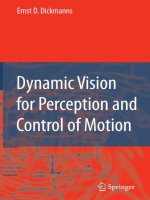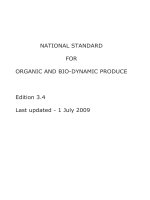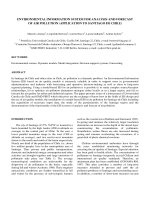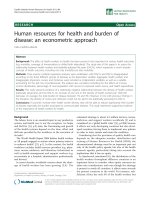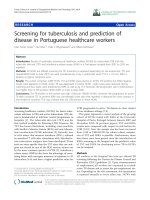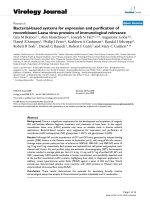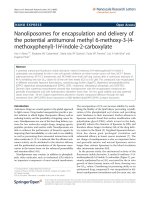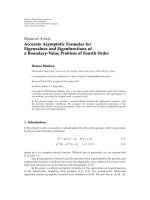IEEE Std 2800™2022IEEE Standard for Interconnection and Interoperability of InverterBased Resources (IBRs) Interconnecting with Associated Transmission Electric Power Systems
Bạn đang xem bản rút gọn của tài liệu. Xem và tải ngay bản đầy đủ của tài liệu tại đây (4.55 MB, 180 trang )
IEEE Power and Energy Society
Developed by the
Energy Development & Power Generation Committee, Electric Machinery
Committee, and Power System Relaying & Control Committee
IEEE Std 2800™-2022
Authorized licensed use limited to: Univ Of Incheon. Downloaded on August 19,2022 at 02:54:33 UTC from IEEE Xplore. Restrictions apply.
STANDARDS
IEEE Standard for Interconnection and
Interoperability of Inverter-Based
Resources (IBRs) Interconnecting with
Associated Transmission Electric
Power Systems
IEEE Std 2800™-2022
IEEE Standard for Interconnection and
Interoperability of Inverter-Based
Resources (IBRs) Interconnecting with
Associated Transmission Electric
Power Systems
Developed by the
Energy Development & Power Generation Committee, Electric Machinery
Committee, and Power System Relaying & Control Committee
of the
IEEE Power and Energy Society
Approved 9 February 2022
IEEE SA Standards Board
Authorized licensed use limited to: Univ Of Incheon. Downloaded on August 19,2022 at 02:54:33 UTC from IEEE Xplore. Restrictions apply.
Abstract: Uniform technical minimum requirements for the interconnection, capability, and lifetime
performance of inverter-based resources interconnecting with transmission and sub-transmission
systems are established in this standard. Included in this standard are performance requirements
for reliable integration of inverter-based resources into the bulk power system, including, but not
limited to, voltage and frequency ride-through, active power control, reactive power control,
dynamic active power support under abnormal frequency conditions, dynamic voltage support
under abnormal voltage conditions, power quality, negative sequence current injection, and system
protection. This standard also applies to isolated inverter-based resources that are interconnected
to an ac transmission system via dedicated voltage source converter high-voltage direct current
(VSC-HVDC) transmission facilities; in these cases, the standard applies to the combination of the
isolated IBRs and the VSC-HVDC facility, and not to an isolated inverter-based resource (IBR) on
its own.
Keywords: active power, capability, co-located resource, control, enter service, energy storage,
evaluation, fast frequency response, frequency, frequency response, harmonic current, harmonic
voltage, hybrid resource, IEEE 2800, integrity, interconnection, interoperability, inverter, inverterbased resource, isolation device, measurement accuracy, modeling, negative-sequence,
performance, positive-sequence, power quality, primary frequency response, protection, reactive
power, reference point of applicability, ride-through, solar photovoltaic power, standard, technical
minimum, transient overvoltage, type test, unbalance, verification, voltage, weak grid, wind power ·
The Institute of Electrical and Electronics Engineers, Inc.
3 Park Avenue, New York, NY 10016-5997, USA
Copyright © 2022 by The Institute of Electrical and Electronics Engineers, Inc.
All rights reserved. Published 22 April 2022. Printed in the United States of America.
IEEE is a registered trademark in the U.S. Patent & Trademark Office, owned by The Institute of Electrical and Electronics
Engineers, Incorporated.
PDF:
Print:
ISBN 978-1-5044-8462-6
ISBN 978-1-5044-8463-3
STD25257
STDPD25257
IEEE prohibits discrimination, harassment, and bullying.
For more information, visit />No part of this publication may be reproduced in any form, in an electronic retrieval system or otherwise, without the prior written permission
of the publisher.
Authorized licensed use limited to: Univ Of Incheon. Downloaded on August 19,2022 at 02:54:33 UTC from IEEE Xplore. Restrictions apply.
Important Notices and Disclaimers Concerning IEEE Standards Documents
IEEE Standards documents are made available for use subject to important notices and legal disclaimers.
These notices and disclaimers, or a reference to this page ( />appear in all standards and may be found under the heading “Important Notices and Disclaimers Concerning
IEEE Standards Documents.”
Notice and Disclaimer of Liability Concerning the Use of IEEE Standards
Documents
IEEE Standards documents are developed within the IEEE Societies and the Standards Coordinating
Committees of the IEEE Standards Association (IEEE SA) Standards Board. IEEE develops its standards
through an accredited consensus development process, which brings together volunteers representing varied
viewpoints and interests to achieve the final product. IEEE Standards are documents developed by volunteers
with scientific, academic, and industry-based expertise in technical working groups. Volunteers are not
necessarily members of IEEE or IEEE SA, and participate without compensation from IEEE. While IEEE
administers the process and establishes rules to promote fairness in the consensus development process, IEEE
does not independently evaluate, test, or verify the accuracy of any of the information or the soundness of
any judgments contained in its standards.
IEEE makes no warranties or representations concerning its standards, and expressly disclaims all warranties,
express or implied, concerning this standard, including but not limited to the warranties of merchantability,
fitness for a particular purpose and non-infringement. In addition, IEEE does not warrant or represent that
the use of the material contained in its standards is free from patent infringement. IEEE standards documents
are supplied “AS IS” and “WITH ALL FAULTS.”
Use of an IEEE standard is wholly voluntary. The existence of an IEEE Standard does not imply that there
are no other ways to produce, test, measure, purchase, market, or provide other goods and services related to
the scope of the IEEE standard. Furthermore, the viewpoint expressed at the time a standard is approved and
issued is subject to change brought about through developments in the state of the art and comments received
from users of the standard.
In publishing and making its standards available, IEEE is not suggesting or rendering professional or other
services for, or on behalf of, any person or entity, nor is IEEE undertaking to perform any duty owed by any
other person or entity to another. Any person utilizing any IEEE Standards document, should rely upon his
or her own independent judgment in the exercise of reasonable care in any given circumstances or, as
appropriate, seek the advice of a competent professional in determining the appropriateness of a given IEEE
standard.
IN NO EVENT SHALL IEEE BE LIABLE FOR ANY DIRECT, INDIRECT, INCIDENTAL, SPECIAL,
EXEMPLARY, OR CONSEQUENTIAL DAMAGES (INCLUDING, BUT NOT LIMITED TO: THE
NEED TO PROCURE SUBSTITUTE GOODS OR SERVICES; LOSS OF USE, DATA, OR PROFITS; OR
BUSINESS INTERRUPTION) HOWEVER CAUSED AND ON ANY THEORY OF LIABILITY,
WHETHER IN CONTRACT, STRICT LIABILITY, OR TORT (INCLUDING NEGLIGENCE OR
OTHERWISE) ARISING IN ANY WAY OUT OF THE PUBLICATION, USE OF, OR RELIANCE UPON
ANY STANDARD, EVEN IF ADVISED OF THE POSSIBILITY OF SUCH DAMAGE AND
REGARDLESS OF WHETHER SUCH DAMAGE WAS FORESEEABLE.
Translations
The IEEE consensus development process involves the review of documents in English only. In the event
that an IEEE standard is translated, only the English version published by IEEE is the approved IEEE
standard.
3
Copyright © 2022 IEEE. All rights reserved.
Authorized licensed use limited to: Univ Of Incheon. Downloaded on August 19,2022 at 02:54:33 UTC from IEEE Xplore. Restrictions apply.
Official statements
A statement, written or oral, that is not processed in accordance with the IEEE SA Standards Board
Operations Manual shall not be considered or inferred to be the official position of IEEE or any of its
committees and shall not be considered to be, nor be relied upon as, a formal position of IEEE. At lectures,
symposia, seminars, or educational courses, an individual presenting information on IEEE standards shall
make it clear that the presenter’s views should be considered the personal views of that individual rather than
the formal position of IEEE, IEEE SA, the Standards Committee, or the Working Group.
Comments on standards
Comments for revision of IEEE Standards documents are welcome from any interested party, regardless of
membership affiliation with IEEE or IEEE SA. However, IEEE does not provide interpretations,
consulting information, or advice pertaining to IEEE Standards documents.
Suggestions for changes in documents should be in the form of a proposed change of text, together with
appropriate supporting comments. Since IEEE standards represent a consensus of concerned interests, it is
important that any responses to comments and questions also receive the concurrence of a balance of interests.
For this reason, IEEE and the members of its Societies and Standards Coordinating Committees are not able
to provide an instant response to comments, or questions except in those cases where the matter has
previously been addressed. For the same reason, IEEE does not respond to interpretation requests. Any person
who would like to participate in evaluating comments or in revisions to an IEEE standard is welcome to join
the relevant IEEE working group. You can indicate interest in a working group using the Interests tab in the
Manage Profile & Interests area of the IEEE SA myProject system. 1 An IEEE Account is needed to access
the application.
Comments on standards should be submitted using the Contact Us form. 2
Laws and regulations
Users of IEEE Standards documents should consult all applicable laws and regulations. Compliance with the
provisions of any IEEE Standards document does not constitute compliance to any applicable regulatory
requirements. Implementers of the standard are responsible for observing or referring to the applicable
regulatory requirements. IEEE does not, by the publication of its standards, intend to urge action that is not
in compliance with applicable laws, and these documents may not be construed as doing so.
Data privacy
Users of IEEE Standards documents should evaluate the standards for considerations of data privacy and data
ownership in the context of assessing and using the standards in compliance with applicable laws and
regulations.
Copyrights
IEEE draft and approved standards are copyrighted by IEEE under US and international copyright laws. They
are made available by IEEE and are adopted for a wide variety of both public and private uses. These include
both use, by reference, in laws and regulations, and use in private self-regulation, standardization, and the
promotion of engineering practices and methods. By making these documents available for use and adoption
by public authorities and private users, IEEE does not waive any rights in copyright to the documents.
1
2
Available at: />Available at: />4
Copyright © 2022 IEEE. All rights reserved.
Authorized licensed use limited to: Univ Of Incheon. Downloaded on August 19,2022 at 02:54:33 UTC from IEEE Xplore. Restrictions apply.
Photocopies
Subject to payment of the appropriate licensing fees, IEEE will grant users a limited, non-exclusive license
to photocopy portions of any individual standard for company or organizational internal use or individual,
non-commercial use only. To arrange for payment of licensing fees, please contact Copyright Clearance
Center, Customer Service, 222 Rosewood Drive, Danvers, MA 01923 USA; +1 978 750 8400;
Permission to photocopy portions of any individual standard for educational
classroom use can also be obtained through the Copyright Clearance Center.
Updating of IEEE Standards documents
Users of IEEE Standards documents should be aware that these documents may be superseded at any time
by the issuance of new editions or may be amended from time to time through the issuance of amendments,
corrigenda, or errata. An official IEEE document at any point in time consists of the current edition of the
document together with any amendments, corrigenda, or errata then in effect.
Every IEEE standard is subjected to review at least every 10 years. When a document is more than 10 years
old and has not undergone a revision process, it is reasonable to conclude that its contents, although still of
some value, do not wholly reflect the present state of the art. Users are cautioned to check to determine that
they have the latest edition of any IEEE standard.
In order to determine whether a given document is the current edition and whether it has been amended
through the issuance of amendments, corrigenda, or errata, visit IEEE Xplore or contact IEEE. 3 For more
information about the IEEE SA or IEEE’s standards development process, visit the IEEE SA Website.
Errata
Errata, if any, for all IEEE standards can be accessed on the IEEE SA Website. 4 Search for standard number
and year of approval to access the web page of the published standard. Errata links are located under the
Additional Resources Details section. Errata are also available in IEEE Xplore. Users are encouraged to
periodically check for errata.
Patents
IEEE Standards are developed in compliance with the IEEE SA Patent Policy. 5
Attention is called to the possibility that implementation of this standard may require use of subject matter
covered by patent rights. By publication of this standard, no position is taken by the IEEE with respect to the
existence or validity of any patent rights in connection therewith. If a patent holder or patent applicant has
filed a statement of assurance via an Accepted Letter of Assurance, then the statement is listed on the IEEE
SA Website at Letters of Assurance may indicate
whether the Submitter is willing or unwilling to grant licenses under patent rights without compensation or
under reasonable rates, with reasonable terms and conditions that are demonstrably free of any unfair
discrimination to applicants desiring to obtain such licenses.
Essential Patent Claims may exist for which a Letter of Assurance has not been received. The IEEE is not
responsible for identifying Essential Patent Claims for which a license may be required, for conducting
inquiries into the legal validity or scope of Patents Claims, or determining whether any licensing terms or
conditions provided in connection with submission of a Letter of Assurance, if any, or in any licensing
Available at: />Available at: />5
Available at: />3
4
5
Copyright © 2022 IEEE. All rights reserved.
Authorized licensed use limited to: Univ Of Incheon. Downloaded on August 19,2022 at 02:54:33 UTC from IEEE Xplore. Restrictions apply.
agreements are reasonable or non-discriminatory. Users of this standard are expressly advised that
determination of the validity of any patent rights, and the risk of infringement of such rights, is entirely their
own responsibility. Further information may be obtained from the IEEE Standards Association.
IMPORTANT NOTICE
IEEE Standards do not guarantee or ensure safety, security, health, or environmental protection, or ensure
against interference with or from other devices or networks. IEEE Standards development activities consider
research and information presented to the standards development group in developing any safety
recommendations. Other information about safety practices, changes in technology or technology
implementation, or impact by peripheral systems also may be pertinent to safety considerations during
implementation of the standard. Implementers and users of IEEE Standards documents are responsible for
determining and complying with all appropriate safety, security, environmental, health, and interference
protection practices and all applicable laws and regulations.
6
Copyright © 2022 IEEE. All rights reserved.
Authorized licensed use limited to: Univ Of Incheon. Downloaded on August 19,2022 at 02:54:33 UTC from IEEE Xplore. Restrictions apply.
Participants
At the time this standard was completed, the Energy Development and Power Generation Committee had the
following officers:
Robert Thorton-Jones, Chair
Kai Strunz, Vice Chair
Michael Negnevitsky, Secretary
Zhenyu Fan, Standards Coordinator
John B. Yale, Past Chair
At the time this standard was completed, the Electric Machinery Committee had the following officers:
James Lau, Chair
Gayland Bloethe, Vice Chair
Edson Bortoni, Secretary
Kay Chen, Standards Coordinator
John Yagielski, Past Chair
At the time this standard was completed, the Power System Relaying Committee had the following officers:
Murty V. V. Yalla, Chair
Michael Thompson, Vice Chair
Gene Henneberg, Secretary
Don Lukach, Standards Coordinator
Russell Patterson, Past Chair
At the time this IEEE standard was completed, the Wind and Solar Plant Interconnection Performance
(WSPI-P) Working Group of the Energy Development and Power Generation Committee had the following
officers:
Jens C. Boemer, Chair
Bob Cummings, Babak Enayati, Ross Guttromson, Mahesh Morjaria, Chenhui Niu, Manish Patel,
Vice Chairs
Diwakar Tewari, Secretary & Treasurer
SubGroup Co-Leads & Facilitators
Jens C. Boemer, SubGroup I—Overall Document
Bob Cummings, SubGroup II—General Requirements
Rajat Majumder, SubGroup III—Active Power-Frequency Response
Rajat Majumder, Wesley Baker, SubGroup IV—Reactive Power-Voltage Control
Shun Hsien (Fred) Huang, SubGroup V—Low Short-Circuit Power
Ramesh Hariharan, SubGroup VI—Power Quality
Bob Cummings, SubGroup VII—Ride-Through Capability
Manish Patel, SubGroup VIII—Ride-Through Performance
Kamal Garg, Michael Jensen, SubGroup IX—Protection
Manish Patel, SubGroup X—Measurement and Modeling
Shazreen Meor Danial, Anderson Hoke, SubGroup XI—Tests and verification requirements
7
Copyright © 2022 IEEE. All rights reserved.
Authorized licensed use limited to: Univ Of Incheon. Downloaded on August 19,2022 at 02:54:33 UTC from IEEE Xplore. Restrictions apply.
In memoriam Kevin Collins, Vice-Chair.
Kevin Collins, our fellow P2800 Officer and Senior Technologist, PV Systems Development, at FirstSolar,
passed away unexpectedly in March 2020. On behalf of all Officers and Working Group members, our utmost
respect and heartfelt gratitude goes out to Kevin and his family. Kevin was at the heart of all the recent
activity in NERC IRPTF and IEEE P2800 since the beginning and will be missed. Kevin was a pioneer in
our industry and has been a cornerstone in our P2800 leadership team. His exceptional contributions in
creating the P2800 “strawman” as well as his thought leadership in facilitating SubGroup III (Active PowerFrequency Response) and SubGroup IV (Reactive Power-Voltage Control), will be remembered by the
industry. Kevin will also be missed as a calm, mature, and balanced voice of reason and empathy in P2800’s
high stakes-stakeholder consensus-building process.
The following working group members participated in finalizing the development of the standard with
working group inputs, and in facilitating the development of those inputs development process:
Hamid Abdelkamel
Syed Ahmad
Krishna Kumar Anaparthi
Noel Aubut
Christy Bahn
Behrooz Bahrani
Philip Baker
William Baker
Hassan Baklou
Abu Bapary
Adrien Bastos
John Bernecker
Debra Best
Rajesh Bhupathi
Sebastien Billaut
Lance Black
Jens C. Boemer
Kevin Brooks
Christopher Burge
Kristina Carmen
Chip Carter
Matthew Ceglia
Kay Chen
Gary Chmiel
Ritwik Chowdhury
Dinah Cisco
Frances Cleveland
Kevin Collins
Jose Cordova
Stephen Crutchfield
Bob Cummings
Randy Cunico
Kevin Damron
Shazreen Meor Danial
Ratan Das
David DeLoach
Alla Deronja
Dian Li Dianzi
James DiLuca
Sabrina Do
A. Doering
Daniel Du
Michael Edds
Antti Eerola
Mohamed Elkhatib
Babak Enayati
Jason Eruneo
Evangelos Farantatos
Roberto Favela
Martin Fecteau
Normann Fischer
Louis Fonte
Francisco Gafaro
James Gahan
John Gajda
Kamal Garg
Durga Gautam
Michael Gerber
Pramod Ghimire
Doug Gischlar
Jonathan Goldsworthy
Bo Gong
Ross Guttromson
Jean-Francois Hache
Aboutaleb Haddadi
Ramesh Hariharan
Jessica Harris
Patrick Hart
Philip Hart
Anderson Hoke
Ali Hooshyar
Pan Hu
Shun Hsien (Fred) Huang
Rich Hydzik
Faheem Ibrahim
Andrew Isaacs
Michael Jensen
Geza Joos
Prashant Kansal
Amir (Reza) Kazemi
Josh Kerr
Michael Kipness
Ruth Kloecker
Gary Kobet
Venkat Reddy Konala
Dan Kopin
Justin Kuhlers
Divya Kurthakoti
Sergey Kynev
Julie Lacroix
James Lau
Kathleen Lentijo
Andrew Leon
Jesse Leonard
Debra Lew
Chun Li
Shuhui Li
Zhen Li
Michael Lombardi
Olushola Jabari Lutalo
Min Lwin
Hongtao Ma
Bruce Magruder
Rajat Majumder
Sudip Manandhar
Gregory Marchini
Bradley Marszalkowski
Pierre-Luc Martel
Aristides Martinez
Jezzel Martinez
Barry Mather
Peter McGarley
Al McMeekin
Rick Meeker
Vahid Mehr
Jonathan Meyer
McPharlen Mgunda
Christopher Milan
Jeremiah Miller
Lipika Mittal
Amir Mohammednur
Mahesh Morjaria
Panayiotis Moutis
David Mueller
Anthony Murphy
Luigi Napoli
David Narang
Robert Nelson
Chenhui Niu
Robert O’Keefe
Mohamed Osman
Siddharth Pant
8
Copyright © 2022 IEEE. All rights reserved.
Authorized licensed use limited to: Univ Of Incheon. Downloaded on August 19,2022 at 02:54:33 UTC from IEEE Xplore. Restrictions apply.
Mahendra Patel
Manish Patel
Evan Paull
Blake D. Peck
Maryclaire Peterson
Jonathan Poirier
Pouyan Pourbeik
Allan Powers
Loren Powers
Ryan Quint
T. Raffield
Farrokh Rahimi
Janos Rajda
Deepak Ramasubramanian
Fernando Ramirez
Reynaldo Ramos
Amy Ridenour
Miguel Rios Rivera
Ciaran Roberts
Fabio Rodriguez
David Roop
Michael Ropp
Edward Ruck
Daniel Sabin
Allen Schriver
Harish Sharma
Nitish Sharma
Mark Siira
Mohit Singh
John Skeath
Gary Smullin
Sachin Soni
Michael Spector
Erin Spiewak
Craig Starr
Wayne Stec
Ravi Subramaniam
Eric Swanger
Diwakar Tewari
Geng Tian
Xingxin Tian
Lukas Unruh
Jim Van De Ligt
Rajiv Varma
Nath Venkit
Reigh Walling
Yi Wang
Robert White
Philip B. Winston
Stephen Wurmlinger
Sophie Xu
John B. Yale
Murty V. V. Yalla
Nicholas Zagrodnik
Malia Zaman
Hayk Zargaryan
David Zech
Jimmy Zhang
George Zhou
Kun Zhu
Songzhe Zhu
9
Copyright © 2022 IEEE. All rights reserved.
Authorized licensed use limited to: Univ Of Incheon. Downloaded on August 19,2022 at 02:54:33 UTC from IEEE Xplore. Restrictions apply.
The following members of the individual Standards Association balloting group voted on this standard.
Balloters may have voted for approval, disapproval, or abstention.
Hamid Abdelkamel
Robert Aiello
Roy Alexander
Marcelo Algrain
Eric Allen
Yazan Alsmadi
Erick Alves
Krishna Kumar Anaparthi
Jay Anderson
Galina Antonova
Andrew Arana
Daniel Arjona
Curtis Ashton
Noel Aubut
Jose Avendano-Mora
JiMyeong Bae
Philip Baker
William Baker
Peter Balma
Abu Bapary
Thomas Barnes
Paul Barnhart
Israel Barrientos
Jeffrey Barsch
Michael Basler
Thomas Basso
David Beach
Robert Beavers
Christopher Belcher
Sebastien Billaut
Wallace Binder
Richard Bingham
Sara Biyabani
Thomas Blackburn
William Bloethe
Jens C. Boemer
James Bougie
Theresa Bowie
Brian Boysen
Jeffrey Bragg
Terence Branch
Roland Brandis IV
Jon Brasher
Pablo Briff
Jeffrey Brogdon
Bill Brown
David Brown
Marlin Browning
Gustavo Brunello
Clayton Burns
Koti Reddy Butukuri
Thomas Callsen
Paul Cardinal
Michael Dana Carlson
Thomas Carpenter
Sean Carr
Juan Carreon
Richard Carter
Leo Casey
Divya Chandrashekhara
Pin Chang
Wen-Kung Chang
Suresh Channarasappa
Brittany Chapman
Thanga Raj Chelliah
Kay Chen
Ke Chen
Zhilei Chen
Gary Chmiel
Iker Chocarro
Ritwik Chowdhury
Dinah Cisco
Frances Cleveland
Nancy Connelly
Larry Conrad
Stephen Conrad
Michael Cowan
Timothy Croushore
Curtis Cryer
Bob Cummings
Randall Cunico
Patrick Dalton
Shazreen Meor Danial
Ratan Das
David Deloach
Alla Deronja
Eugene Dick
David Dickmander
Mamadou Diong
Thomas Domitrovich
Kevin Donahoe
Michael Dood
Neal Dowling
Herbert Dreyer
Donald Dunn
Benjamin Ealey
Michael Edds
Antti Eerola
Mohamed Elkhatib
Paul Elkin
Zakia El Omari
Zia Emin
Babak Enayati
William English
Johan H. Enslin
Lei Ertao
Evangelos Farantatos
Roberto Favela
Martin Fecteau
Kevin Fellhoelter
James Feltes
Curtis Fischer
Normann Fischer
Rostyslaw Fostiak
Dale Fox
Carl Fredericks
Regina Gao
Rafael Garcia
Kamal Garg
Shubhanker Garg
Jonathan Gay
Michael Geocaris
Kenneth Gettman
Farangmeher Ghadiali
Pramod Ghimire
Jalal Gohari
Bo Gong
Lou Grahor
Henry Gras
Stephen Grier
Glenn Griffin
J. Travis Griffith
Keith Grzegorczyk
Nathan Gulczynski
Mark Gutzmann
Aboutaleb Haddadi
Joshua Hambrick
Ramesh Hariharan
Robert Harris
Kyle Hawkings
Roger Hayes
Roger Hedding
Kyle Heiden
Gene Henneberg
Steven Hensley
Mariana Hentea
Chris Heron
Lee Herron
Michael Higginson
Ryan Hinkley
Werner Hoelzl
Robert Hoerauf
Anderson Hoke
Ali Hooshyar
Eric Hope
Sheikh Jakir Hossain
John Houdek
Yi Hu
Shun-Hsien (Fred) Huang
Richard Hunt
Faiz Ikramulla
Michael Ingram
Andrew Isaacs
Dmitry Ishchenko
Richard Jackson
Brad Jensen
Michael Jensen
Anthony Johnson
Brian Johnson
Jay Johnson
Steven Johnston
Andrew Jones
Innocent Kamwa
Prashant Kansal
10
Copyright © 2022 IEEE. All rights reserved.
Authorized licensed use limited to: Univ Of Incheon. Downloaded on August 19,2022 at 02:54:33 UTC from IEEE Xplore. Restrictions apply.
Gordon Kawaley
John Kay
Amir (Reza) Kazemi
Peter Kelly
Yashar Kenarangui
Chad Kennedy
Gael Kennedy
Sheldon Kennedy
Gregory Kern
Stuart Kerry
Irfan Khan
Yuri Khersonsky
James Kinney
Gary Kobet
Boris Kogan
Zaccaria Koita
Venkat Reddy Konala
Lawrence Kotewa
Benjamin Kroposki
Justin Kuhlers
Jacob Kulangara
Jim Kulchisky
Vinoth Kumar
Ruediger Kutzner
Hillmon Ladner-Garcia
Thomas Ladson
Chung-Yiu Lam
Daniel Lambert
Mario Lanaro
Justin Lane
Andrew Larkins
Raluca Lascu
James Lau
An Le
Daniel Lebeau
Wei-Jen Lee
Andrew Leon
Giancarlo Leone
Debra Lew
Shuhui Li
Ting Li
William Lockley
Michael Lombardi
Federico Lopez
Olushola Jabari Lutalo
Brian Lydic
Bruce Mackie
Afshin Majd
Rajat Majumder
Mario Manana Canteli
Tapan Manna
Timothy Marrinan
Hugo Marroquin
Bradley Marszalkowski
John Martin
Barry Mather
Slobodan Matic
Kevin Mayor
James McConnach
Ed McCullough
Thomas McDermott
Jeffrey McElray
Peter McGarley
Hank McGlynn
Sean McGuinness
Brian McMillan
Peter McNutt
Robert Messel
McPharlen Mgunda
Christopher Milan
Dean Miller
Nicholas Miller
James Mirabile
Bhaskar Mitra
Jeff Mizener
Ali Moeini
Sepehr Mogharei
Hossein Ali Mohammadpour
Amir Mohammednur
Jose Monteiro
Mahesh Morjaria
Christopher Mouw
Adi Mulawarman
Jerry Murphy
Anthony Murphy
Pratap Mysore
K. R. M. Nair
Anthony Napikoski
Arun Narang
David Narang
Alexandre Nassif
Cesar Negri
Dennis Neitzel
Steven Nelson
Robert Nelson
Arthur Neubauer
Kwok Kei Simon Ng
James Niemira
Joe Nims
Nayeem Ninad
Chenhui Niu
Samuel Norman
Matthew Norwalk
James O’Brien
Robert O’Keefe
Mohamed Osman
Umut Ozdogan
Sivaraman P.
Lorraine Padden
Marty Page
Siddharth Pant
Dwight Parkinson
Bansi Patel
Mahendra Patel
Manish Patel
Pathik Patel
Subhash Patel
Marc Patterson
Arumugam Paventhan
Stephen Pell
Howard Penrose
Branimir Petosic
Christopher Petrola
Sylvain Plante
Jeffrey Pond
Pouyan Pourbeik
Allan Powers
William Quaintance
Patrick Quinn
Ryan Quint
Ulf Radbrandt
Ion Radu
Bradley Railing
Deepak Ramasubramanian
Benito Ramos
Moises Ramos
Reynaldo Ramos
Lakshman Raut
James Reilly
Mark Reynolds
Miguel Rios Rivera
Bruce Rockwell
Diego Rodriguez
Charles Rogers
David Roop
Michael Ropp
James Rossman
Edward Ruck
Christopher Ruckman
Daniel Sabin
Christian Sanchez
Janette Sandberg
William Saylor
Steven Saylors
Bartien Sayogo
Allen Schriver
Carl Schuetz
Robert Schultz
Dustin Schutz
Kenneth Sedziol
Uwe Seeger
Daniel Seidel
Edward Seiter
Robert Seitz
Gab-Su Seo
Alkesh Shah
Devki Sharma
Harish Sharma
Nitish Sharma
Robert Sherman
Nigel Shore
Stephen Shull
Mark Siira
Hyeong Sim
Gaurav Singh
Mohit Singh
John Skeath
James Smith
Jerry Smith
Joshua Smith
Gary Smullin
Sachin Soni
Joseph Sowell
Michael Spector
Lincoln Sprague
Wayne Stec
11
Copyright © 2022 IEEE. All rights reserved.
Authorized licensed use limited to: Univ Of Incheon. Downloaded on August 19,2022 at 02:54:33 UTC from IEEE Xplore. Restrictions apply.
Andrew Steffen
Eugene Stoudenmire
Candace Suh-Lee
Chase Sun
Scott Sweat
Humayun Tariq
David Tepen
Diwakar Tewari
Michael Thompson
Robert Thornton-Jones
Xingxin Tian
Craig Turner
Eric Udren
Lukas Unruh
Onur Usmen
Jaryn Vaile
James Van De Ligt
Benton Vandiver
Luis Vargas
Rajiv Varma
Jason Varnell
Gerald Vaughn
Nath Venkit
John Vergis
Jane Verner
Quintin Verzosa
Ilia Voloh
Sandeep Vuddanti
Matthew Wakeham
Sukhdev Walia
Sarah Walinga
Christopher Walker
David Wallace
Reigh Walling
Peter Walsh
John Wang
Joe Warner
John Webb
Kenneth White
Robert White
Kevin Whitener
Aaron Wilson
Philip B. Winston
Rachel Wood
Terry Woodyard
Stephen Wurmlinger
John Yagielski
John B. Yale
Murty V. V. Yalla
Richard York
Oren Yuen
Kipp Yule
Mohammad Reza Dadash Zadeh
Nicholas Zagrodnik
Abu Zahid
Vahraz Zamani
Francisc Zavoda
David Zech
Timothy Zgonena
Jinhua Zhang
Cezary Zieba
Karl Zimmerman
When the IEEE SA Standards Board approved this standard on 9 February 2022, it had the following
membership:
David J. Law, Chair
Vacant Position, Vice Chair
Gary Hoffman, Past Chair
Konstantinos Karachalios, Secretary
Edward A. Addy
Ted Burse
Ramy Ahmed Fathy
J. Travis Griffith
Guido R. Hiertz
Yousef Kimiagar
Joseph L. Koepfinger*
Thomas Koshy
John D. Kulick
Johnny Daozhuang Lin
Kevin Lu
Daleep C. Mohla
Andrew Myles
Damir Novosel
Annette D. Reilly
Robby Robson
Jon Walter Rosdahl
Mark Siira
Dorothy V. Stanley
Lei Wang
F. Keith Waters
Karl Weber
Sha Wei
Philip B. Winston
Daidi Zhong
*Member Emeritus
12
Copyright © 2022 IEEE. All rights reserved.
Authorized licensed use limited to: Univ Of Incheon. Downloaded on August 19,2022 at 02:54:33 UTC from IEEE Xplore. Restrictions apply.
Introduction
This introduction is not part of IEEE Std 2800-2022, IEEE Standard for Interconnection and Interoperability of InverterBased Resources (IBRs) Interconnecting with Associated Transmission Electric Power Systems.
IEEE Std 2800™ was the first of a series of standards developed by IEEE Power and Energy Society Energy
Development and Power Generation Committee concerning transmission-connected inverter-based resources
interconnection. The additional documents in that series are as follows:
IEEE P2800.1 6 provides guidance on (conformance) test (and verification) procedures for inverterbased resources interconnecting with associated transmission systems (TSs).
IEEE P2800.2™ provides recommended practices on conformance tests and verification procedures
for inverter-based resources interconnecting with transmission and sub-transmission systems.
As with any IEEE standard, the applicability of IEEE Std 2800, IEEE P2800.1, or IEEE P2800.2 to given
IBR is determined by the authority governing interconnection requirements (AGIR) for that location. IEEE
P2800.1 and IEEE P2800.2 are under development at the time of this standard’s adoption, and their drafts
are designated IEEE P2800.1 and IEEE P2800.2, respectively.
The first publication of IEEE Std 2800 was an outgrowth of the recommendations from the North American
Electric Reliability Corporation (NERC) Inverter-Based Resources Performance Reliability Guideline
[B75] 7 and IEEE Std C57.12.80™ [B63]. Instances in this standard where the entities involved and
coordinating in the IBR interconnection process, i.e., TS owner, TS operator, load balancing entity, IBR
owner, IBR operator, and IBR developer, are mentioned and resemble functional responsibilities of the North
American regulatory framework; AGIRs are encouraged to adopt this standard with entity functional
responsibilities as applicable to the given regulatory framework.
Acknowledgements
Grateful acknowledgements to the Inverter-Based Resources Performance Working Group (IRPWG) of the
North American Electric Reliability Corporation (NERC) that provided their Reliability Guideline
Improvements to Interconnection Requirements for BPS-Connected Inverter-Based Resources [B76] as a
strawman for an early draft of this standard.
Permissions have been granted as follows:
Definitions in 3.1 reprinted or modified with permission from International Electrotechnical Commission (IEC):
Maximum current ac, Imax (IEEE Std C62.39™-2012, modified from IEC 62319-1:2005)
IBR continuous rating (ICR) (adapted from IEC 62934 ED1)
Mode (adapted from IEC 904-03-09)
Solar photovoltaic system (solar PV) (adapted from IEC 60050)
Wind turbine generator (WTG) (adapted from IEC 60050)
Figure 5 reprinted with permission from the Electric Power Research Institute (EPRI), © 2020.
Figure 10 reprinted with permission from The Regents of the University of California through Lawrence
Berkeley National Laboratory, © 2020.
The author thanks the International Electrotechnical Commission (IEC) for permission to reproduce
information from its International Standards. All such extracts are copyright of IEC Geneva, Switzerland.
6
Numbers preceded by P are IEEE authorized standards projects that were not approved by the IEEE-SA Standards Board at the time
this publication went to press. For information about obtaining drafts, contact the IEEE.
7
The numbers in brackets correspond to the numbers of the bibliography in Annex A.
13
Copyright © 2022 IEEE. All rights reserved.
Authorized licensed use limited to: Univ Of Incheon. Downloaded on August 19,2022 at 02:54:33 UTC from IEEE Xplore. Restrictions apply.
All rights reserved. Further information on the IEC is available from www.iec.ch. IEC has no responsibility
for the placement and context in which the extracts and contents are reproduced by the author, nor is IEC in
any way responsible for the other content or accuracy therein.
IEC 60050-904 ed.1.0 Copyright © 2014 IEC Geneva, Switzerland. www.iec.ch
IEC 60050-602 ed.1.0 Copyright © 1983 IEC Geneva, Switzerland. www.iec.ch
IEC 62319-1-1 ed.1.0 Copyright © 2005 IEC Geneva, Switzerland. www.iec.ch
IEC 62934:2021 Copyright © 2021 IEC Geneva, Switzerland.www.iec.ch
14
Copyright © 2022 IEEE. All rights reserved.
Authorized licensed use limited to: Univ Of Incheon. Downloaded on August 19,2022 at 02:54:33 UTC from IEEE Xplore. Restrictions apply.
Contents
1. Overview ...................................................................................................................................................18
1.1 General ...............................................................................................................................................18
1.2 Scope ..................................................................................................................................................19
1.3 Purpose ...............................................................................................................................................19
1.4 General remarks and limitations .........................................................................................................19
1.5 Word usage .........................................................................................................................................25
2. Normative references.................................................................................................................................25
3. Definitions, acronyms, and abbreviations .................................................................................................26
3.1 Definitions ..........................................................................................................................................26
3.2 Acronyms and abbreviations ..............................................................................................................39
4. General interconnection technical specifications and performance requirements .....................................41
4.1 Introduction ........................................................................................................................................41
4.2 Reference points of applicability (RPA) .............................................................................................43
4.3 Applicable voltages and frequency .....................................................................................................44
4.4 Measurement accuracy .......................................................................................................................45
4.5 Operational measurement and communication capability ..................................................................46
4.6 Control capability requirements..........................................................................................................46
4.7 Prioritization of IBR responses ...........................................................................................................47
4.8 Isolation device ...................................................................................................................................48
4.9 Inadvertent energization of the TS......................................................................................................48
4.10 Enter service .....................................................................................................................................48
4.11 Interconnection integrity ...................................................................................................................49
4.12 Integration with TS grounding ..........................................................................................................50
5. Reactive power-voltage control requirements within the continuous operation region .............................51
5.1 Reactive power capability...................................................................................................................51
5.2 Voltage and reactive power control modes .........................................................................................55
6. Active-power—frequency response requirements.....................................................................................57
6.1 Primary frequency response (PFR) .....................................................................................................57
6.2 Fast frequency response (FFR) ...........................................................................................................62
7. Response to TS abnormal conditions ........................................................................................................68
7.1 Introduction ........................................................................................................................................68
7.2 Voltage ...............................................................................................................................................68
7.3 Frequency ...........................................................................................................................................79
7.4 Return to service after IBR plant trip ..................................................................................................82
8. Power quality .............................................................................................................................................83
8.1 Limitation of voltage fluctuations induced by the IBR plant ..............................................................83
8.2 Limitation of harmonic distortion .......................................................................................................84
8.3 Limitation of overvoltage contribution ...............................................................................................87
9. Protection...................................................................................................................................................88
9.1 Frequency protection ..........................................................................................................................88
9.2 Rate of change of frequency (ROCOF) protection .............................................................................89
9.3 AC voltage protection .........................................................................................................................89
9.4 AC overcurrent protection ..................................................................................................................89
9.5 Unintentional islanding protection......................................................................................................89
9.6 Interconnection system protection ......................................................................................................90
15
Copyright © 2022 IEEE. All rights reserved.
Authorized licensed use limited to: Univ Of Incheon. Downloaded on August 19,2022 at 02:54:33 UTC from IEEE Xplore. Restrictions apply.
10. Modeling data ..........................................................................................................................................90
11. Measurement data for performance monitoring and validation ...............................................................92
12. Test and verification requirements ..........................................................................................................98
12.1 Introduction ......................................................................................................................................98
12.2 Definitions of verification methods ..................................................................................................98
12.3 Conformance verification framework .............................................................................................101
Annex A (informative) Bibliography ..........................................................................................................106
Annex B (informative) Inverter-based resource (IBR) interconnection examples ......................................112
B.1 AC interconnection examples ..........................................................................................................112
B.2 DC interconnection examples ..........................................................................................................114
B.3 Complex IBR plant examples ..........................................................................................................115
Annex C (informative) Inverter stability and system strength.....................................................................119
C.1 Introduction to transmission-connected inverter-based resources (IBRs) ........................................119
C.2 System strength and select metrics ..................................................................................................123
C.3 Inverter-based resource stability ......................................................................................................130
C.4 Grid-forming inverters .....................................................................................................................136
Annex D (informative) Illustration of voltage ride-through capability requirements ..................................140
D.1 Interpretation of voltage ride-through capability requirements .......................................................140
D.2 Informative figures for voltage ride-through capability requirements .............................................143
Annex E (informative) Recommended practices for voltage harmonics of inverter-based resources (IBRs)
.....................................................................................................................................................................146
E.1 Introduction ......................................................................................................................................146
E.2 Harmonic limits ................................................................................................................................149
E.3 Verification and adherence evaluation .............................................................................................149
Annex F (informative) Guidance on setting protection with inverter-based resources (IBRs)....................151
F.1 Frequency protection ........................................................................................................................151
F.2 Rate of change of frequency (ROCOF) protection ...........................................................................151
F.3 AC voltage protection.......................................................................................................................151
F.4 AC overcurrent protection ................................................................................................................152
F.5 Unintentional islanding protection ...................................................................................................152
F.6 Interconnection system protection ....................................................................................................153
Annex G (informative) Recommendation for modeling data ......................................................................154
G.1 General.............................................................................................................................................154
G.2 Steady-state modeling data requirements ........................................................................................154
G.3 Stability analysis dynamic modeling data requirements ..................................................................156
G.4 Electromagnetic transient (EMT) dynamic modeling data requirements ........................................157
G.5 Power quality, flicker, and rapid voltage change (RVC) modeling data requirements ....................160
G.6 Short-circuit modeling data requirements ........................................................................................160
Annex H (informative) Data that transmission system (TS) owner and TS operator may provide to the
inverter-based resource (IBR) developer .....................................................................................................161
H.1 System data ......................................................................................................................................161
H.2 Interconnection ratings ....................................................................................................................163
Annex I (informative) Illustration of voltage ride-through performance requirements ...............................164
16
Copyright © 2022 IEEE. All rights reserved.
Authorized licensed use limited to: Univ Of Incheon. Downloaded on August 19,2022 at 02:54:33 UTC from IEEE Xplore. Restrictions apply.
Annex J (informative) Type III wind turbine generator (WTG) challenges with controllability of negativesequence current during unbalanced faults ..................................................................................................168
Annex K (informative) Guidance on fast frequency response (FFR) ..........................................................170
K.1 Introduction to FFR variants ............................................................................................................170
K.2 Variants of FFR ...............................................................................................................................170
K.3 Conditions for return to normal operations ......................................................................................173
K.4 Performance when returning to normal operations ..........................................................................173
Annex L (informative) Damping ratio .........................................................................................................174
Annex M (informative) Consecutive voltage deviation ride-through capability of isolated inverter-based
resources (IBRs) interconnected via voltage source converter high-voltage direct current (VSC-HVDC).177
17
Copyright © 2022 IEEE. All rights reserved.
Authorized licensed use limited to: Univ Of Incheon. Downloaded on August 19,2022 at 02:54:33 UTC from IEEE Xplore. Restrictions apply.
IEEE Standard for Interconnection and
Interoperability of Inverter-Based
Resources (IBRs) Interconnecting with
Associated Transmission Electric
Power Systems
1. Overview
1.1 General
The global increase in penetration levels of inverter-based resources (IBRs) is expected to significantly
change the dynamic performance of the power grid. As the penetration levels of inverter-based resources
increase and the technology of inverter-based resources evolves, specifications and standards are needed to
address the performance requirements of inverter-based resources. Currently, there is no single document of
consensus on the performance requirements covering inverter-based resources interconnected with
transmission and sub-transmission systems. Events in North America, such as the Blue Cut Fire Disturbance
(NERC “1,200 MW Fault” [B72]) as well as the inappropriate use of IEEE Std 1547™ [B50] for large-scale
solar plants, underscore this need. 8 This new standard is a first attempt to address the need for consensusbased performance requirements and can help equipment manufacturers, project developers, transmission
planners, and power grid operators improve the quality of the inverter and facility performance to enhance
the stability of the power grid over a transmission planning horizon. 9 The specified requirements are intended
to strike a balance between the state of the art and forward-looking technology capabilities, while considering
the uncertainties as to how a future bulk power system with high amounts of IBR may be planned and
operated. Given that IEEE standards are voluntary industry standards, enforcement of any of the requirements
specified in this standard will require its adoption by the regional authority governing interconnection
requirements (AGIR). An AGIR is a cognizant and responsible entity that defines, codifies, communicates,
administers, and enforces the policies and procedures for allowing electrical interconnection of inverterbased resources interconnecting with associated transmission systems.
8
An Inverter-Based Resource Performance Task Force (IRPTF) of the North American Electric Reliability Corporation (NERC) issued
a white paper [B74] identifying gaps in NERC Reliability Standards, including FAC-001-3 [B90], FAC-002-2 [B91], MOD-026-1
[B93], MOD-027-1 [B94], PRC-002-2 [B96], PRC-024-2 [B97], TPL-001-4 [B98], VAR-002-4.1 [B99]; standard authorization requests
(SARs) are underway to close these gaps.
9
Transmission planning may address bulk system stability over the next one or two decades.
18
Copyright © 2022 IEEE. All rights reserved.
Authorized licensed use limited to: Univ Of Incheon. Downloaded on August 19,2022 at 02:54:33 UTC from IEEE Xplore. Restrictions apply.
IEEE Std 2800-2022
IEEE Standard for Interconnection and Interoperability of Inverter-Based Resources (IBRs) Interconnecting with
Associated Transmission Electric Power Systems
1.2 Scope
This standard establishes the required interconnection capability and performance criteria for inverter-based
resources interconnected with transmission and sub-transmission systems. 10, 11, 12 Included in this standard
are performance requirements for reliable integration of inverter-based resources into the bulk power system,
including, but not limited to: voltage and frequency ride-through, active power control, reactive power
control, dynamic active power support under abnormal frequency conditions, dynamic voltage support under
abnormal voltage conditions, power quality, negative sequence current injection, and system protection. This
standard shall also be applied to isolated inverter-based resources that are interconnected to an ac
transmission system via a dedicated voltage source converter high-voltage direct current (VSC-HVDC)
transmission facility; in these cases, the standard shall apply to the combination of the isolated IBR and the
VSC-HVDC facility and shall not apply to the isolated IBR unless they serve as a supplemental IBR device
that is necessary for the IBR plant with VSC-HVDC to meet the requirements of this standard at the reference
point of applicability.
1.3 Purpose
This standard provides uniform technical minimum requirements for the interconnection, capability, and
performance of inverter-based resources interconnecting with transmission and sub-transmission systems.
1.4 General remarks and limitations
The criteria and requirements in this document are applicable to all inverter-based resource technologies
interconnected to transmission systems (TSs) (i.e., both meshed/networked and radial transmission and subtransmission) voltage levels. For radial sub-transmission systems, this standard intentionally overlaps with
potential application of IEEE Std 1547™, in which case it remains at the discretion of the authority governing
interconnection requirements (AGIR) to decide which standard is applicable.
The application of this standard may be limited to IBR plants for which interconnection requests are
submitted after the date by which this standard is enforced by the responsible authority governing
interconnection requirements (AGIRs); this standard may not apply to IBR plants that are either already
interconnected or for which interconnection requests had been submitted prior to the standard’s enforcement
date (grandfathering). Any substantial changes in an existing IBR plant, e.g., the “repowering” of a wind
power plant, may require retrofitting that IBR plant to meet all of the requirements of this standard.
The stated capability and performance requirements are universally needed for interconnection of IBR plants
to transmission and sub-transmission systems and their interoperability, and will be sufficient for most
installations. This standard specifies technical minimum interconnection, capability, and performance
requirements for an IBR plant, its IBR unit(s), and if present and as applicable, its supplemental IBR
device(s). 13 While this standard specifies uniform technical minimum requirements, the TS operator and TS
owner may, in a non-discriminatory way, specify different and/or additional requirements than those
specified in this standard for the safe and reliable operations of their system. Non-compliance of the IBR
10
Requirements apply to inverter-based resources (IBRs) only, e.g., solar photovoltaic, wind, and energy storage systems or
combinations of such. This excludes any systems that are not resources, e.g., flexible ac transmission systems (FACTS) and synchronous
condensers, and any resources that are not inverter-based, e.g., gas and steam power plants with synchronous generators.
11
This standard does not explicitly specify requirements for HVDC. However, it specifies requirements for inverter-based resources
(generation and storage) and that includes isolated IBR that are interconnected to an ac transmission system via a dedicated voltage
source converter (VSC) high-voltage direct current (HVDC) transmission facility, e.g., an offshore wind park. In these cases, the
combination of isolated IBR and VSC-HVDC transmission facility is regarded as the IBR to which this standard is applicable. This
standard is not intended to specify requirements for VSC-HVDC that connect two buses in a meshed synchronous ac system.
12
Resources with doubly-fed generators (DFGs) are defined as IBR, but requirements specified for IBR plants with DFG in this standard
may slightly differ, where appropriate.
13
Most of the requirements specified in this standard apply to the IBR plant; however, they are not intended to apply to each equipment
within the IBR plant. When designing components within an IBR plant it is normally necessary to consider the applicable design
standards, but it may also be necessary to meet more stringent requirements as determined in the IBR plant design evaluation (see
12.2.3).
19
Copyright © 2022 IEEE. All rights reserved.
Authorized licensed use limited to: Univ Of Incheon. Downloaded on August 19,2022 at 02:54:33 UTC from IEEE Xplore. Restrictions apply.

